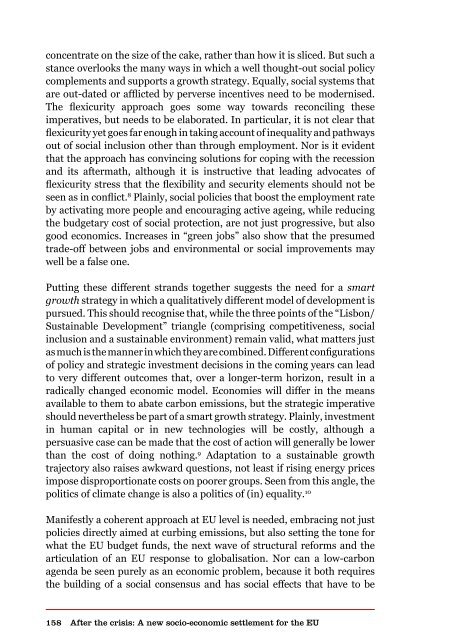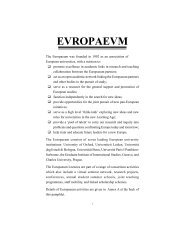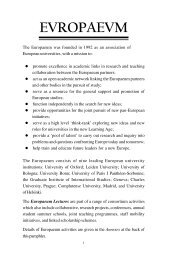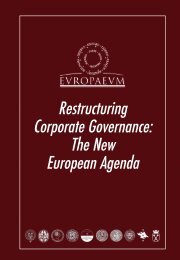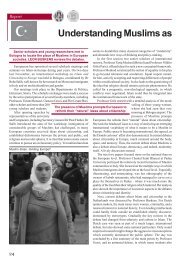Authors Iain Begg | Gabriel Glöckler | Anke Hassel ... - The Europaeum
Authors Iain Begg | Gabriel Glöckler | Anke Hassel ... - The Europaeum
Authors Iain Begg | Gabriel Glöckler | Anke Hassel ... - The Europaeum
Create successful ePaper yourself
Turn your PDF publications into a flip-book with our unique Google optimized e-Paper software.
concentrate on the size of the cake, rather than how it is sliced. But such a<br />
stance overlooks the many ways in which a well thought-out social policy<br />
complements and supports a growth strategy. Equally, social systems that<br />
are out-dated or afflicted by perverse incentives need to be modernised.<br />
<strong>The</strong> flexicurity approach goes some way towards reconciling these<br />
imperatives, but needs to be elaborated. In particular, it is not clear that<br />
flexicurity yet goes far enough in taking account of inequality and pathways<br />
out of social inclusion other than through employment. Nor is it evident<br />
that the approach has convincing solutions for coping with the recession<br />
and its aftermath, although it is instructive that leading advocates of<br />
flexicurity stress that the flexibility and security elements should not be<br />
seen as in conflict. 8 Plainly, social policies that boost the employment rate<br />
by activating more people and encouraging active ageing, while reducing<br />
the budgetary cost of social protection, are not just progressive, but also<br />
good economics. Increases in “green jobs” also show that the presumed<br />
trade-off between jobs and environmental or social improvements may<br />
well be a false one.<br />
Putting these different strands together suggests the need for a smart<br />
growth strategy in which a qualitatively different model of development is<br />
pursued. This should recognise that, while the three points of the “Lisbon/<br />
Sustainable Development” triangle (comprising competitiveness, social<br />
inclusion and a sustainable environment) remain valid, what matters just<br />
as much is the manner in which they are combined. Different configurations<br />
of policy and strategic investment decisions in the coming years can lead<br />
to very different outcomes that, over a longer-term horizon, result in a<br />
radically changed economic model. Economies will differ in the means<br />
available to them to abate carbon emissions, but the strategic imperative<br />
should nevertheless be part of a smart growth strategy. Plainly, investment<br />
in human capital or in new technologies will be costly, although a<br />
persuasive case can be made that the cost of action will generally be lower<br />
than the cost of doing nothing. 9 Adaptation to a sustainable growth<br />
trajectory also raises awkward questions, not least if rising energy prices<br />
impose disproportionate costs on poorer groups. Seen from this angle, the<br />
politics of climate change is also a politics of (in) equality. 10<br />
Manifestly a coherent approach at EU level is needed, embracing not just<br />
policies directly aimed at curbing emissions, but also setting the tone for<br />
what the EU budget funds, the next wave of structural reforms and the<br />
articulation of an EU response to globalisation. Nor can a low-carbon<br />
agenda be seen purely as an economic problem, because it both requires<br />
the building of a social consensus and has social effects that have to be<br />
158<br />
After the crisis: A new socio-economic settlement for the EU


